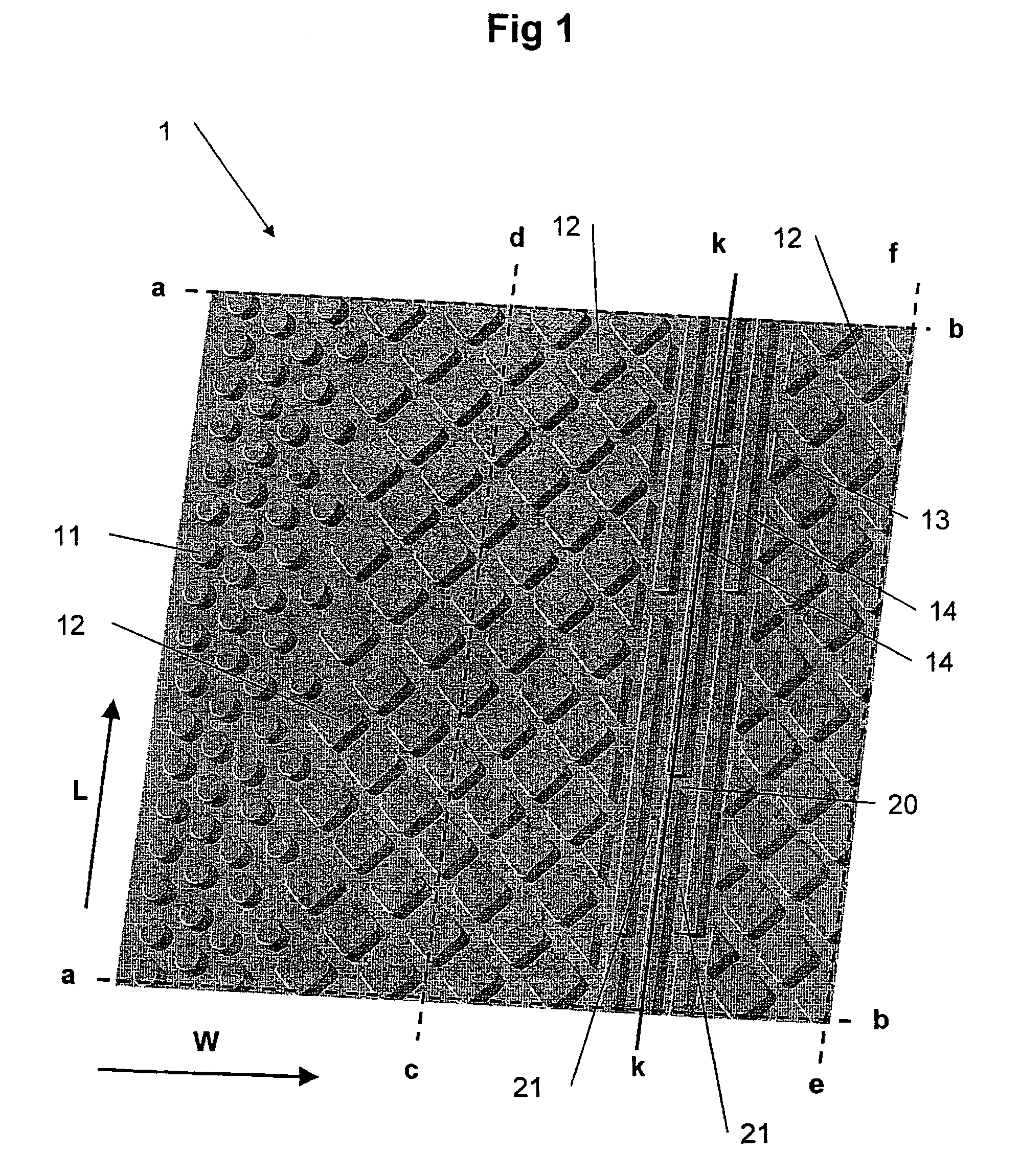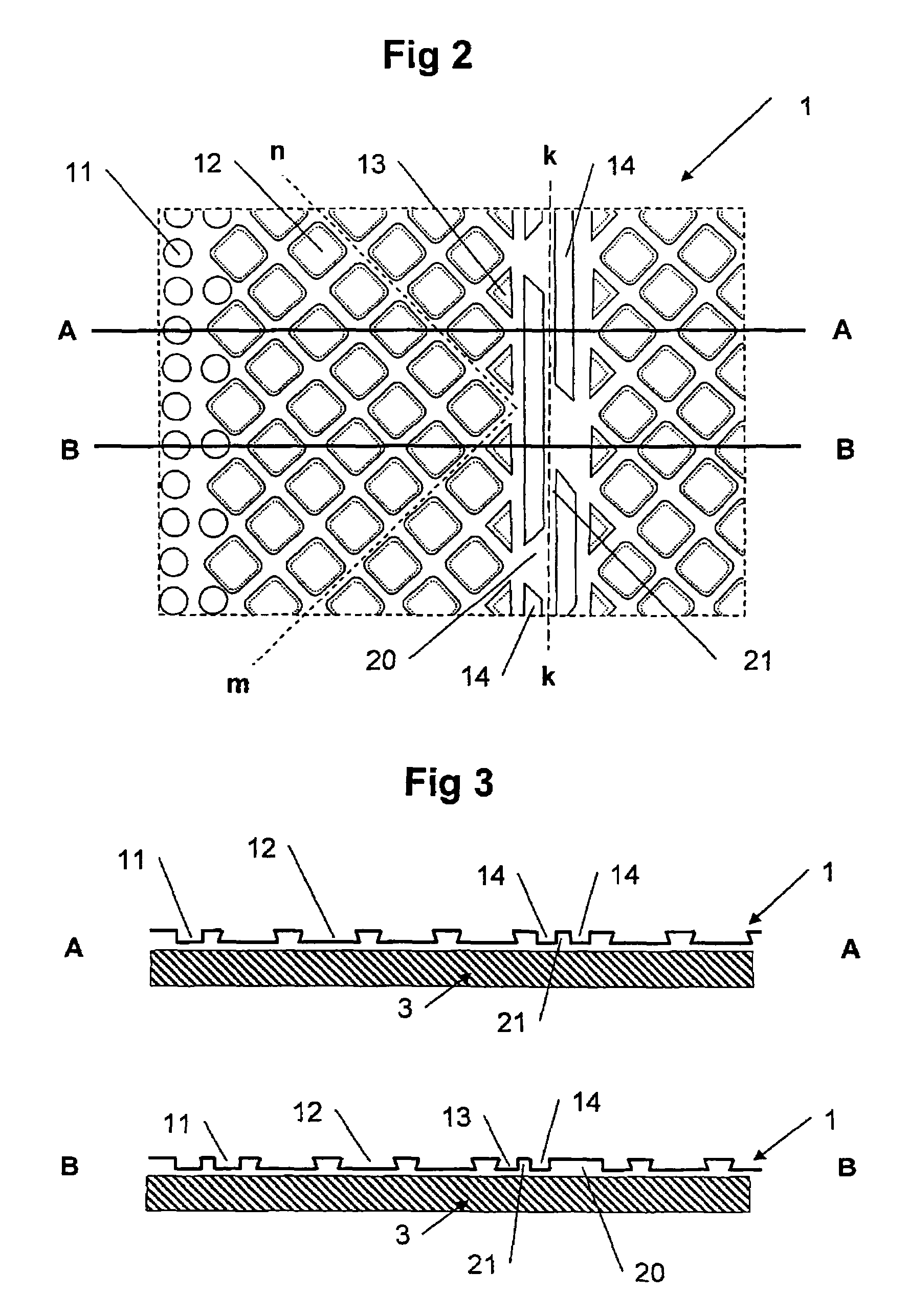Studded plate with fold line
a technology of plate and fold line, applied in the direction of treads, building components, protective foundations, etc., can solve the problems of difficult detection, inability to place concrete directly on the floor, and inability to place concrete floor coverings such as wooden floors, so as to reduce the risk of capillary action in a simple and sure manner
- Summary
- Abstract
- Description
- Claims
- Application Information
AI Technical Summary
Benefits of technology
Problems solved by technology
Method used
Image
Examples
first embodiment
[0040]the invention is shown in FIG. 1, which is a part of a studded plate according to the invention. The plate has a longitudinal direction L and normally such sheets are rolled up in lengths of 20 meters. The plate has a transverse direction W, and the width of a sheet is normally about 1 or 2 meters. The height of the studs in this example is constant at about 3 millimeters, but may be smaller or larger or possibly of varying height.
[0041]In the longitudinal direction, the plate is divided in areas of different widths, comprising different types of studs 11, 12, 13 and 14 of different shapes and sizes when following the line a-b. The width of the different areas may vary and the line c-d designates an unidentified width. The line e-f marks an incomplete longitudinal edge as the plate may have different widths, either with the same type of studs, or other studs as shown on other parts of the plate in FIG. 1.
[0042]As may be seen from FIG. 1, an edge area of round small studs 11 is...
second embodiment
[0048]In order to better understand the shape of the studs, a similar second embodiment of a studded plate 1 is shown in FIG. 2, viewed from the bottom side with two marked sectional lines A-A and B-B. In FIG. 3 the profiles of cross sections A-A and B-B are represented with the plate placed against a substrate 3.
[0049]In order to fasten the studded plate to the substrate, it is an advantage, as mentioned initially, to use a fabric or a grid 2 as shown in FIG. 4 which may be applied to the studded plate in advance. The top of the studs 11, 12, 13 and 14 in FIG. 1 are for example provided with a fabric 2 in FIG. 4 of a suitable material by adhesive or lamination. This fabric 2 may then be used for fixing the plate to the substrate, such as a concrete floor or a wall, either permanently or temporarily. In FIG. 5 the profiles of the cross sections C-C and D-D are respectively reproduced when the plate 1 with fabric 2 is placed against a floor 3. As may be seen from the FIG. 5, the offs...
third embodiment
[0052]FIG. 8 shows a plate according to the invention comprising a fold line. In this embodiment the main areas comprise two types of studs, such as circular studs 112 and propeller shaped studs 110, both of which have undercuts, although somewhat offset. The fold line is made up of a central longitudinal row of oblong propeller shaped studs 114, and one row on each side, comprising oblong studs 113. As in the embodiments described earlier, this arrangement also secures a continuous air gap when the plate is folded in 90° along the line k-k which is the centre line of the folding crease. A continuous air gap is secured through the combination of channels 120 generally in the transverse direction and channels 121 generally in the longitudinal direction. The staggering of the studs in the three rows of the fold line will also prevent an optional fabric 2 on the bottom side of the plate in blocking the channels.
PUM
| Property | Measurement | Unit |
|---|---|---|
| length | aaaaa | aaaaa |
| width | aaaaa | aaaaa |
| width | aaaaa | aaaaa |
Abstract
Description
Claims
Application Information
 Login to View More
Login to View More - R&D
- Intellectual Property
- Life Sciences
- Materials
- Tech Scout
- Unparalleled Data Quality
- Higher Quality Content
- 60% Fewer Hallucinations
Browse by: Latest US Patents, China's latest patents, Technical Efficacy Thesaurus, Application Domain, Technology Topic, Popular Technical Reports.
© 2025 PatSnap. All rights reserved.Legal|Privacy policy|Modern Slavery Act Transparency Statement|Sitemap|About US| Contact US: help@patsnap.com



